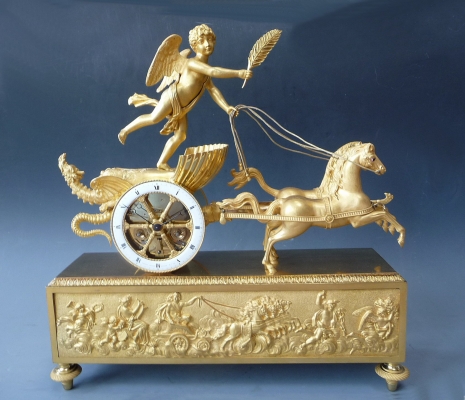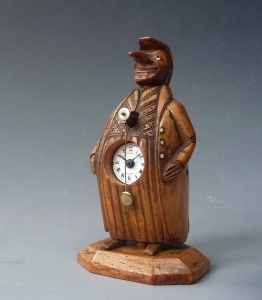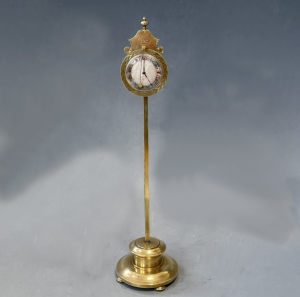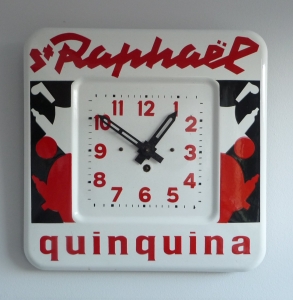“Cupid’s Chariot”, a French Empire gilt bronze figural mantel clock, Le Roy, Palais Royal à Paris, c. 1810.
“Cupid’s Chariot”, a French Empire gilt bronze figural mantel clock, Le Roy, Palais Royal à Paris, c. 1810. A French Empire gilt bronze figural mantel clock after model by Jean-Simon Deverberie (1724–1824), the round enamel dial ring with Roman numerals is set in the wheel of a chariot. The sculpture shows a chariot drawn by two spirited horses with enamel eyes and with a fire-breathing dragon making up its back portion, the front being composed of a shell on which Cupid stands holding a symbolic whip, rectangular base decorated with figures in relief. Elke Niehüser gives a wonderful description of the mythological representation Clock with an 8 day movement, silk suspension, striking at hours and halves on a bell. Dimensions HxWxD 49 x 46 x 15 cm. Price € 18.500,-- Literature : Pierre Kjellberg , Encyclopédie de la pendule française, page 416. Elke Niehüser, Die Französische Bronzeuhr, page 103. Text: "On the base relief Apollo / Helios passes through the heaven firmament with swirling speed. As if in a victory march, a winged genius with a lush filled basket and the goddess Mercury preceded him. To his entourage belongs the writing muse, which is surrounded by the attributes of her sister, a putto holds the laurel wreath. Apollo shows himself as "Musagetes" - leader of the Muses. Perhaps in the doubling of the triumphal motive, the competition of the two gods is represented visually, the last of the tender Amor-boy defeated the mighty god". Original text "Auf dem Sockelrelief durchfährt Apollo/Helios den Himmelskreis mit wolkenwirbelnder Schnelligkeit. Wie in einem Triumphzug eilen ihn ein ihm ein geflügelter Genius mit üppig gefülltem Korb und der Götterbode Merkur voraus. Zu seinem Gefolge gehört die schreibende Muse, die von den Attributen ihrer Schwester umgeben ist, ein Putto hält den Lorbeerkranz. Apollo zeigt sich so als „Musagetes“ – Anführer der Musen. Möglicherweise ist hier in der Verdoppelung des Triumphmotivs die Konkurrenz der beiden Götter optisch dargestellt, die der zuletzt der zarte Amorknabe den mächtigen Gott besiegt".
- Reference:
- 100-318
Contact
Van Dreven Antiquair
Fred van Dreven
Prinsengracht 483, 1016 HP Amsterdam, The Netherlands
E-mail: dreven@xs4all.nl
Mobile: +31 (0)6 536 434 43
View in person?
Visit showroom, by appointment.









